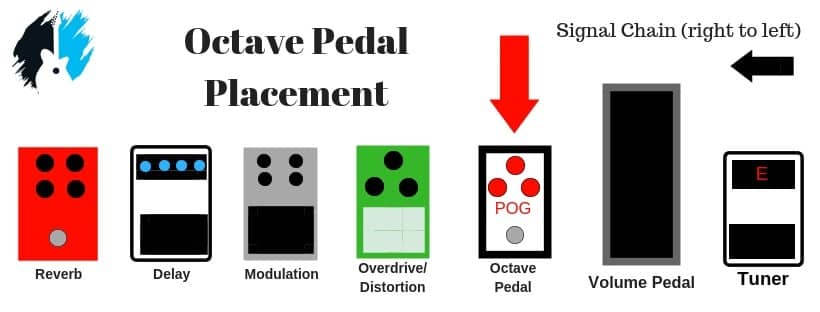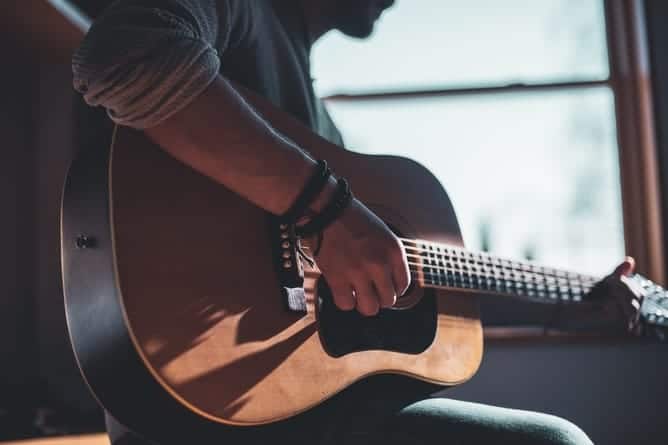
Adding an octave pedal to any signal chain gives players the freedom to come up with a creative and interesting range of sounds.
But with players new to pedal order, you may be wondering where does the octave pedal usually go on a pedalboard…
Well with my experience, this post is all about ideal placement, how placement affects tone, applying it for acoustic, and why every guitar player needs an octave pedal in their set-up.
The Answer…
So what is the usual order for an octave pedal within the effects signal chain?
An octave pedal is traditionally positioned at the ‘beginning’ of the effects chain. After the tuner and volume pedal, but before the ‘drive section.’ This placement ensures the ‘cleanest signal’ through the pedal allowing the notes and chords to be tracked ‘cleanly’ and ‘reproduced’ when the effect is activated.
If you did not happen to know already, ‘tracking’ translates to how well a pedal can ‘detect notes’ through a guitar signal when it is engaged.
Pedalboard Example
With the help of this useful infographic below. Here is an example of a basic pedalboard arrangement with an octave pedal Included. Remember, the signal chain begins from right to left…

If you are new to octave pedals and only recently started adopting an octave pedal within your individual sound (good choice by the way) this order is a good place to start.
Keep in mind, with most pedals whether its distortion, overdrive, delay, reverb, etc. There is no ‘exact science’ when it comes to pedal placement order.
Why Pedal Order Can Be Subjective
The reason being the way you order you pedals has a big impact on your other pedals which affects the overall sound and tone.
Meaning pedal order can be very subjective to the player hinging on the sounds and tone an individual wants to create based on their tastes and unique playing style.
This is why being a guitar player can be so fun! Spending hours experimenting with different pedal orders combined with guitars, amps, and settings to sculpt and mold our ideal sound.
The next common question with octave pedals which can be pondered by guitarists. Is whether to place the octave pedal before or after the overdrive section? Both choices have a big impact on the octave pedals functionality and sound.
Octave Pedal ‘Before’ or ‘After’ Distortion/Drive?
As mentioned, pedal order makes a big difference to the effectiveness of your pedal which impacts the overall sound when combined with other pedals on your board.
As I have stated, there are no rules when it comes to pedal order. However, there are some key areas where an octave pedal prefers to be positioned within a signal chain.
The Answer
Traditionally, an octave pedal is positioned ‘before’ any distortion or drive. This is because they work optimally when a clearer signal is coming through the unit.
This allows the unit to track notes and reproduce them effectively and combine optimally with other effects within the signal chain.
Why ‘After’ Is Not Ideal
Positioning your octave pedal ‘after’ the distortion translates to sending a distorted signal through the octave pedal, hindering its ability to pick out notes and reproduce them clearly.
Essentially, distortion, overdrive, and fuzz will ‘color’ and ‘mask’ the notes being sent into your octave pedal.
Positioning your octave pedal after the overdrive in this way, will octave the distortion, which is not useful tonally and is not a sound desired by most guitar players.
Ideally, you want to apply the octave pedal on a raw guitar signal so it can effectively track notes.
The take home point is this you want to ‘distort the octaves,‘ not ‘octave the distortion.’ I know this is tricky to understand but read it a few times until it sinks in!
As mentioned, this is all subjective to each individual player. As always I recommend experimenting with your gear as much as possible to find a winning combination that combines the best for your individual sound.
Octave Pedal ‘Before’ or ‘After’ Looper?
The traditional and simplest way to position a looper pedal is at the end of the chain (left). Being at the end of the chain allows the looper to record and loop all of your pedalboard at that present moment.
As mentioned, the octave pedal will go at the beginning of the signal chain allowing your notes to track more effectively. Both pedals, therefore, are far apart from each other in the signal chain as they differ in function.
The looper records the signal as a whole, while the octave pedal interprets and reproduces the guitar’s notes individually for applying octaves and pitch shift effects
Where to Position Looper pedal?
As we have learned, positioning an octave pedal is pretty straight forward. However, things can get more complicated when it comes to different looper pedal arrangements.
Unlike an octave pedal, you can position a looper pedal at the beginning and end of the signal chain depending on your preferences.
Both positions produce varying functions depending on which suits you best. If you plan on using a looper, knowing how looper pedal positioning can affect function will be very useful to know.
End of the Chain
Placing a looper pedal at the end of the signal chain (the most common way) will directly record your pedalboard exactly how you the pedals arranged and whatever is engaged at that present moment.
Meaning the sound of the loop will not react whether you active or deactivate effects as the loop plays.
For example, let’s say you loop a ‘crunchy’ rock rhythm chord progression. You then enable an overdrive pedal as a boost for a solo over the top of the progression.
The crunchy rhythm section will not be affected meaning you can now add an overdrive pedal for a boosted solo over the layered rhythm so now your boosted solo can effectively stand out from the rhythm.
Beginning of the Chain
In contrast, placing the looper pedal at the beginning of the chain can modify the raw signal in ‘real time.’
For example, you can record a looped riff then to change the dynamic of the riff, engage a drive, reverb or delay pedal to add a new texture to the riff as it is looping.
This can make the riff a different animal altogether. This set-up is a popular arrangement for live performances as you can record then engage effect pedals for different sections of a song.
When starting out with looper pedals choosing to place the pedal at the end of the chain is the most simple set up.
After some experience and you get good at looping, play around with the loopers arrangement on your pedalboard and see what order works for you and your playing.
Make Your Electric Guitar Sound Like a Bass

Another popular way octave pedals are utilized by guitar players, is to recreate the sound of a bass guitar by configuring the pedal an ‘octave below’ (12 notes below the root note.)
Giving the audible illusion of a bass guitar especially when playing notes on the low register strings (low E & A strings.)
Add in a looper pedal and believe me, this is hours of fun, looping basslines to then noodle over the top with licks and solos. As a guitar player, this set up can let your creativity flow for creating some fun and musical arrangements.
Now depending on the brand and function of the octave pedals, some are designed to do this better than others. As not as all octave pedals are created equally each one having their strengths and weaknesses. Without going into too much depth, some octave pedals are designed for optimal use for…
- Vintage tones (Jimmy Hendrix style)
- Adding distortion fuzz or overdrive
- Track notes better than others
- Expression pedal function
- Detuning notes
- Masking the original note
- Pitch shifting (weird synth sounds)
- Lo-Fi sounds
How to Make Guitar Sound Like Bass Using Octave Pedal
Creating a bass guitar sound can be achieved by most octave pedals when you set them correctly.
As mentioned, a bass is tuned down one octave lower (12 notes) than an electric guitar. So configuring the pedal down one whole octave will recreate the sound of bass using your regular guitar.
Depending on the pedal this can be done by maxing out the ‘suboctave’ control, then killing the ‘dry’ control which will kill the sound of the guitar’s notes. Also by removing any ‘sub-harmonics’ from the pedal to remove any pitch shifting synth sounds.
Ideally, you want a pedal that can lower the root note by one octave and also remove or mask the guitars original note out of the signal effectively.
This is so the main sound you can hear from the amp is the bass octave lower notes which will sound more similar to bass guitar frequencies than a regular electric guitar for creating basslines.
Best Octave Pedal for Sounding Like a Bass
My recommendation, therefore, for the best octave pedal for recreating the sound of deep and fat bass sounds with your regular electric. Would be the simple yet effective Boss OC-3 Super Octave Pedal.
This pedal can go down as much as two octaves for a deep bass tone using your electric guitar. Renowned by the YouTube guitar community for being the best pedal for accurate creating a solid bass sound.
Although this pedal is not as versatile as other pedals on the market and can not go up many octaves as, unlike other octave pedals. This is a solid purchase if you do not have an octave pedal already.
How Octave Pedals Can be Utilized for Acoustic

For a solo acoustic player utilizing a looper, an octave pedal is a very useful addition for playing a bassline combined with percussive rhythm. creating the illusion of a full band performance with one guitar.
Adding Basslines
Adding a bassline to an acoustic looper style performance fills the song with more instruments allowing the song to be more dynamic and adding an additional element of realism. Plus, it is fun to play around with different basslines and noodle around with different songs allowing you to be creative.
Not only can the pedal be used for octaves. They are used by solo acoustic guitarists for bringing percussive sounds to life when using an acoustic guitar.
Percussion
For example, when a solo acoustic player records percussive loops (kick drumk/snare) layering the foundation of a song. Ie creating a 4/4 beat by hitting the strings or slapping the body of the acoustic which sets the beat of the song.
An engaged octave pedal helps pickup up the low-end frequencies and the bottom-end sound of the percussion. This gives the percussion more character and ‘oomph’ for getting a ‘snappy’ and ‘crisp’ percussive sound by just using an acoustic guitar.
This lays the foundation for a solid beat for an acoustic player to then layer acoustic rhythm and other arrangements over the top. The versatility of this pedal means there are a ton of uses and functions for an octave pedal when you know how to use it correctly.
Tone Creation with Octave pedals
An octave pedal is a very versatile addition to any signal chain, adding flavor, dynamics, and character to your tone depending, on how you choose to utilize the pedal.
Clean Tones
Using an octave pedal combined with a simple ‘boring’ clean tone can be adopted for a range of styles. For example, engage an octave pedal set with an octave down with a bright clean tone. This combination can transform a once ‘boring’ and ‘dull’ tone for playing funky lead licks.
Another way to adopt a pitch shift octave pedal with an ambient pedalboard set up for sweeping and ‘trance-like’ guitars swells.
With a clean tone engaged, combine it with a volume pedal, reverb, delay, and other optional pedals. An octave pedal can serve in creating some ‘ambient’ and unusual ‘textures’ with interesting ‘soundscapes.’
Here is a great post I wrote, explaining how you can use a volume pedal for producing ‘ambient’ guitar swells! Give it a read here!
Lead Tones
Octave pedals combined with your dirty section (distortion, overdrive, fuzz) can give your tone more aggression and a new dynamic edge for an ‘in your face’ sound.
For me personally, I like using an octave pedal with a fuzz pedal engaged for a ‘screaming lead tone’ Jimmy Hendrix style (minus the playing ability.)
How you set this section up will also depend on the intensity of your dirt section coming from your overdrive, distortion or fuzz. For example, ‘subtle clean boost,’ ‘warm lead tone,’ ‘mid gain,’ ‘high gain saturation’ etc. It all depends on you as the player.
Just be noted the more distortion you use after the overdrive, the notes begin to sound additionally ‘colored.’ This can be ideal for creating ‘detuned’ and ‘dark’ sound passages and textures.
I have only scratched the surface when it comes to tonal variety and octave pedals here. However, watch this video to see the full tonal capabilities with all types of octave pedals.
Related Questions
Can an Octave pedal be run through an amps effects loop?
The effects loop is traditionally designed for pedals that are planned to go after distortion within the effects chain. These pedals are usually (delay, reverb, flanger, modulation etc.) Octave pedals alternatively are designed to go before the distortion.
Can Octave pedals run on 9V batteries?
Depending on the manufacturer and model of the pedal. Most octave pedals will run using a 9V battery if the compartment is large enough to house it. Alternatively, they will operate with a 9V power adapter.
